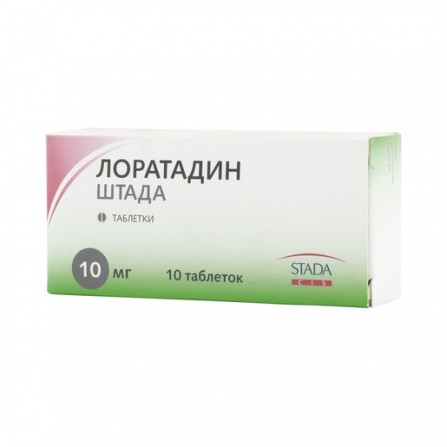Loratadin-Stad pills 10mg N10
Condition: New product
1000 Items
Rating:
Be the first to write a review!

More info
Active ingredients
Loratadine
Release form
Pills
Composition
Loratadine 10 mg. Auxiliary substances: lactose, calcium stearate, colloidal silicon dioxide (aerosil), ludipress.
Pharmacological effect
Loratadine - a blocker of histamine H1 receptors (long-acting). Inhibits the release of histamine and leukotriene C4 from mast cells. Prevents the development and facilitates the course of allergic reactions. It has antihistamine, antiallergic, antipruritic and anti-exudative action. Reduces capillary permeability, prevents the development of tissue edema, relieves spasm of smooth muscles. The antiallergic effect develops after 30 minutes, reaches a maximum after 8 to 12 hours and lasts 24 hours. It does not affect the central nervous system and does not cause addiction (because it does not penetrate the blood-brain barrier).
Pharmacokinetics
Quickly and completely absorbed in the digestive tract. Tmax - 1.3-2.5 h; food intake slows it down by 1 hour. Cmax in the elderly increases by 50%, with alcoholic liver damage, depending on the severity of the disease. Communication with plasma proteins - 97%. Metabolized in the liver to form the active metabolite of descarboethoxyloratadine with the participation of cytochrome P450, CYP3A4 and, to a lesser extent, CYP2D6 isoenzymes. Equilibrium concentration of loratadine and metabolite in plasma is achieved on the 5th day of administration. Does not penetrate the BBB. T1 / 2 loratadine - 3-20 hours (average 8.4 hours), active metabolite - 8.8-92 hours (average 28 hours); in elderly patients, respectively - 6.7-37 hours (average 18.2 hours) and 11-38 hours (17.5 hours). When alcoholic liver damage T1 / 2 increases depending on the severity of the disease. Excreted by the kidneys and with bile. In patients with chronic renal failure and during hemodialysis, the pharmacokinetics are virtually unchanged.
Indications
- seasonal and perennial allergic rhinitis (including pollinosis); - allergic conjunctivitis; - urticaria (including chronic idiopathic); - Quincke edema; - allergic pruritic dermatosis; - pseudo-allergic reactions; - allergic reactions to insect bites - itching of various etiologies.
Contraindications
- hypersensitivity; - pregnancy, lactation period; - children's age up to 3 years. With caution: liver failure.
Precautionary measures
Application for violations of the liver functionWith caution: liver failure. Application in childrenContraindicated in children under 3 years of age.
Use during pregnancy and lactation
Contraindicated in pregnancy, during lactation.
Dosage and administration
Inside Adults and children over 12 years: 10 mg (1 tab.) 1 time / day.Daily dose of 10 mg. Children from 3 to 12 years old 5 mg (1/2 tab.) 1 time / day. Daily dose - 5 mg. Children with a body weight of more than 30 kg - 10 mg of the drug 1 time / day. Daily dose - 10 mg.
Side effects
The adverse events listed below with loratadine were observed with a frequency of> 2% and about the same frequency as with placebo ("pacifiers"). In adults: headache, fatigue, dry mouth, drowsiness, gastrointestinal frustration (nausea, gastritis), and also allergic reactions in the form of rash. In addition, there were rare reports of anaphylaxis, alopecia, abnormal liver function, palpitations, and tachycardia. Children rarely have headache, nervousness, and sedation.
Overdose
Symptoms: drowsiness, tachycardia, headache. In case of overdose, consult a doctor. Treatment: induction of vomiting, gastric lavage, taking activated charcoal.
Interaction with other drugs
Ethanol reduces the effectiveness of loratadina. Erythromycin, cimetidine, ketoconazole, with a combined use of the language of efficacy of loratadine.
special instructions
Influence on the ability to drive motor vehicles and control mechanisms. During the period of treatment, it is necessary to refrain from engaging in potentially hazardous activities that require increased concentration of attention and speed of psychomotor reactions.




